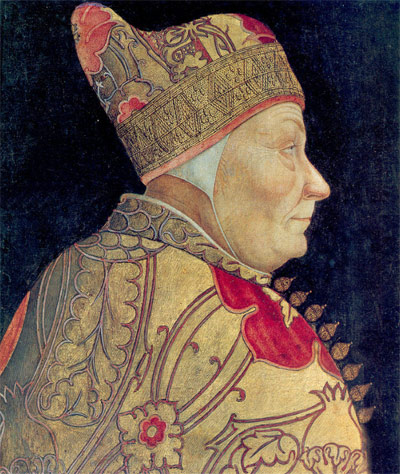The Sanctuary was built in 1435, following an apparent Marian apparition, while one of the periodic plague epidemics was raging.
Pietro Falco, an injured military at the time, decided to retire in prayer in a grove at the foot of Monteortone to find relief from his ailments. Towards the end of May 1428, the Blessed Virgin Mary, Mother of God, would have appeared to him and invited him to immerse himself in the ancient thermal spring. There, he would have been healed and would have found an icon-painting of the Virgin Mary with the divine Son in her arms. This work is still kept in the artistic Sacello located at the end of the main altar. The Virgin Mary would have invited to construct a church-sanctuary, along with a conversion of heart for people, in exchange for the plague's cessation.
The plague did end coincidently, and the news of the apparent miracle immediately aroused the interest of the Paduan Rectors and the Doge of Venice at the time, Francesco Foscari.
 Francesco Foscari
Francesco FoscariThe religious fervor was such that the Serenissima Republic of Venice, with the approval of the bishop of Padua, considered it appropriate to assign two monks to the place. Later, the Augustinian friar and prior, Simone da Camerino, who also promoted the construction of the sanctuary and the adjacent monastery of the Augustinians of Monteortone, was assigned as well.
Donations to complete the construction multiplied so much that the first church could already be opened for worship on 28 August 1435, the day of Saint Augustine's feast. There was an almost immediate increase in the community's 'Hermits of Monteortone' monks.
There is also an ancient plaque within the site that is placed as a remembrance of the negotiations, between Francesco Sforza, lord of Milan and the Doge of Venice Francesco Foscari, that led to the peace of Lodi signed on 9 April 1454.
Other main contributors to the sanctuary's construction would have been Pietro Lombardo, Tullio Lombardo, and Baldassarre Longhena. The hardships suffered at the time do not allow us to clearly identify their implication.
The remains of Friar Simone are kept in a tomb at the foot of the main altar.